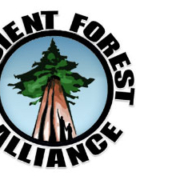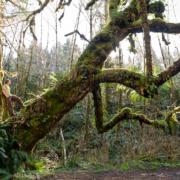A March gale hissed through the treetops, spinning sudden flurries of an early spring snow into the canopy 10 storeys above our heads.
The wind sounded like surf on a distant beach but down on the mossy forest floor of what the province’s forestry maps officially designate as DL33, the world was as still as a cemetery.
Not a breath of air stirred the witch’s hair dangling from branches. Salal, sword ferns and Oregon grape were motionless except for the occasional droplet of condensed water that plopped from somewhere above to splatter on a glossy leaf.
As I picked my way noiselessly along the narrow, springy trail above a slow creek, its tea-coloured pools filled with moss-draped deadfalls, I was reminded again of the astonishing palette of greens and greys and earth tones that illuminate the coastal forest in winter.
These months when spring hasn’t made up its mind that winter is over are supposed to be the gloomy time, but the array of mosses, lichens and ferns, punctuated by the occasional gleam of fungi, suffused the forest landscape with a luminous quality that seemed strangely amplified by the silence.
We edged by a massive arbutus tree, its tossing crown lost somewhere above where it stretched for the light among the towering Douglas firs they call veterans. Some of these trees can live a thousand years or more. We crossed the boggy throat of the stream. It drained from a marsh, its waters still as a mirror around spiky clumps of sedge.
Then we paused at a moss-covered space. It swept down to a huge, rotting nurse log. Who knows how long it had lain there? These fallen trees can take up to 500 years to decompose, slowly releasing their nutrients into the surrounding soil and creating a host of new habitats for worms, insects, lichens, huckleberries and the saprophytes sustained by dead organic material.
Kathy McMaster, my guide for the morning and an embattled citizen advocate for this forest about half an hour’s drive north of Nanaimo, gestured to the swath of moss. “Indian pipe grows through there.” Indian pipe, ghost pipe, corpse plant, ice plant — whatever you call it, this relatively rare little flower is one of the mysterious wonders of B.C., a plant with none of the chlorophyll that is essential for photosynthesis, which converts light into usable energy and colours leaves green.
A rare treed landscape
It was once thought to be a saprophyte, taking its energy from rotting things, but botanists discovered Indian pipe is actually a parasitic plant. Its roots are hosts to a kind of fungi which themselves form an intricate, lace-like web through decaying leaves until they reach tree roots from which they extract sugar that they carry back to feed the flower.
This interdependent existence might serve as a metaphor for the whole miraculous meshing of the elaborate ecosystem we call the moist maritime coastal Douglas fir forest, itself the rarest and most endangered of the province’s treed landscapes, one that also sustains 29 of the province’s endangered species.
“Coastal Douglas fir is now fragmented because almost 40 per cent of it has been changed from its natural condition into settlements and agricultural land,” points out Helen Reid, a vegetation ecologist who works with the Cowichan Tribes. “And it is depleted because 99 per cent of it has been logged, so there is less than one per cent in a natural or old growth condition.”
In fact, strictly speaking, DL33 is one of those modified landscapes because it, too, experienced some limited logging about a century ago. But that occurred at a time when technology precluded the kind of clear-cutting that later became prevalent, so the stand is now a mixture of substantial portions of ancient forest and some mature second growth.
This makes it a prime candidate for recruitment as a recovering forest, one that’s well on the way to restoration to its pristine state of old growth and thus might help reverse the decline toward ecosystem extinction.
“Even small parcels like DL33 make important contributions to conservation of coastal Douglas fir,” Reid says. “It is in good condition with mostly mature and old forests that would serve as areas for conservation and recovery.”
Furthermore, the Nanoose Streamkeepers Society points out that DL33 also contains the only remaining intact watershed of any tributary supplying Nanoose Creek, a wild salmon stream in which coho and chum spawn, and that the untouched watershed provides habitat for cutthroat trout, red-legged frogs and Roosevelt elk in addition to plant and insect species.
These towering Douglas fir veterans studded through the groves of younger trees are what provincial scientists define as a “keystone species” — one that influences the entire ecosystem of more than 100 other plant species and at least 400 types of insect that inhabit the treetops. Strip the canopy by logging the Douglas firs and that whole complex understorey is exposed to the elements and quickly is replaced by other invasive species more suited to the changed conditions.
B.C.’s Conservation Data Centre further identifies 20 plant communities containing different combinations of species — for example, the Douglas fir and dull Oregon grape that I’d just walked through, or the Indian pipe colony — that are considered endangered. In 2005, the province’s Forest Practices Board said all these coastal Douglas fir plant communities were either “critically imperilled” or “imperilled” within B.C. and that many were endangered on a global scale. Critically imperilled means “at very high risk of extinction” and imperilled means “at high risk of extinction.”
“Nearly every type of old growth Douglas fir forest on British Columbia’s dry coastal plain is now rare or endangered,” confirms B.C.’s environment ministry. “Only one half of one per cent [about 1,100 hectares] of the low coastal plain is covered by relatively undisturbed old forest. This is far below what scientists consider to be the minimum area required for continued survival of these forest types.”
So the coastal Douglas fir ecosystem that once dominated the Georgia basin now teeters at the brink of extinction and most of what does remain is the ethical responsibility of British Columbians.
This is why the provincial environment ministry set out a policy objective both for members of the public and for itself regarding this particular endangered ecosystem:
“Support government programs that create incentives for private landowners to protect the forests on their properties,” the ministry urged citizens. “Governments can also protect the few remnants that are on public lands, improve the management of forests within parks and create new parks by buying private lands that support oldgrowth Douglas fir forests.”
Indeed, a conservation planning report for the province in 2007 warned that without aggressive protection there’s a high likelihood that it will not be possible to maintain the ecological integrity of this forest type into the future. Another provincial agency, the integrated land management bureau, reported in 2008 that “negligible mature and old forest remains with the coastal Douglas fir” forest zone.
But the next thing McMaster showed me was logging tape festooned throughout the forest. This particular publicly owned fragment of a forest ecosystem that’s already been destroyed and degraded over more than 99.5 per cent of its range in the Georgia Basin could soon be logged with approval of the provincial government, McMaster says, all part of a plan to help first nations diversify their economies by creating resource development opportunities pending treaty deals.
“I don’t believe it is the first nation’s fault they have been given a licence to harvest such an ecologically endangered forest,” McMaster said. “I understand that first nations have been marginalized, but I believe in this case there are better alternatives. It is standard practice, if there aren’t less sensitive forests to log in this area, that they can be given a parcel to log outside their traditional territory. I don’t believe DL33 will survive being logged. I cannot endorse allowing the coastal Douglas fir [ecosystem] to become extinct for the sake of helping first nations find their new way.”
McMaster says she’s been characterized as a NIMBY — “not in my back yard” — because her backyard is, indeed, adjacent to the forest. “This is everybody’s back yard,” she counters.
Reid agrees that logging the small parcel of forest would lower its conservation value and increase the downward trend of depletion of the old and mature stands that must be maintained if the natural ecosystem is to function. “The loss of DL33 adds incrementally to the tilt toward extinction of coastal Douglas fir ecosystems,” Reid says. “The data suggest that there are still enough second-growth stands to recover coastal Douglas fir ecosystem function, but time is running out.
“As a vegetation ecologist I cannot support the logging of DL33 because I believe that second-growth stands that are viable for rebuilding old growth, such as DL33, are needed for conservation, or coastal Douglas fir will go extinct.”
An immoral policy
Extinction. The word carries enormous moral freight. Is this something to which anyone wants to contribute?
So McMaster has a strong point. Finding ways to generate economic growth and development for B.C.’s long and unjustly marginalized first nations communities is admirable, but co-opting them into helping to shoot the last buffalo in order to achieve economic independence seems unpardonably cynical on the part of government.
It might make for good politics to off-load the conflicting values onto first nations and environmentalists, but it makes for immoral policy.
The Forest Practices Board said in 2005 that the best surviving remnants of coastal Douglas fir forest on the southeast coast of Vancouver Island where endangered plant communities could be saved from extinction were those “with veteran trees and predominantly natural regeneration, particularly where sites were only lightly disturbed by the original harvesting activities.”
This sounds like precisely the definition of this small, soon-to-be logged coastal Douglas fir site at Nanoose Bay.
And it raises several important questions:
First, why would this particular parcel be placed on the agenda for industrial development by the province? It’s not as though it was desperately needed to meet economic obligations to first nations. The province’s own chief forester reported in the summer of 2009 that the timber supply for the region is robust and that even removing all the remaining coastal Douglas fir from the logging inventory would result in only a 2.8-per-cent decrease in the long-term harvest.
Second, where’s Environment Minister Barry Penner on this crucial issue? Why does he appear to be missing in action? Is environmental policy in this province dictated by bean counters in the forest ministry or spin-doctoring policy wonks? This isn’t just about timber supply and meeting economic needs of first nations, it’s about the shoddy ethics of appearing to meet those needs by contributing incrementally to the possible extinction of an entire ecosystem.
After all, it was the province’s environment ministry that first pointed out that:
“Even if efforts to protect all remaining old-growth stands are successful, additional areas of older second-growth forest will have to be protected and allowed to recover to an oldgrowth state in order to ensure adequate representation of these forest types in the future.”
Old-growth forests contain trees that live up to 1,000 years. That’s just about the term of the lease the province negotiated for BC Rail right-of-way. It seems plausible that if the province can work with those time spans to preserve its interest in a strip of gravel and railway ties, it can find short-term solutions that both protect the most endangered landscapes under its stewardship and meet the needs of first nations without requiring them to destroy their own sacred patrimony.
“A rarity among rarities,” is how McMaster described it. “It exists nowhere else in the world and we are responsible for preserving it for future generations.” That means all of us, starting with the provincial government, which shouldn’t be allowed to dodge its responsibility by passing the buck to first nations.




